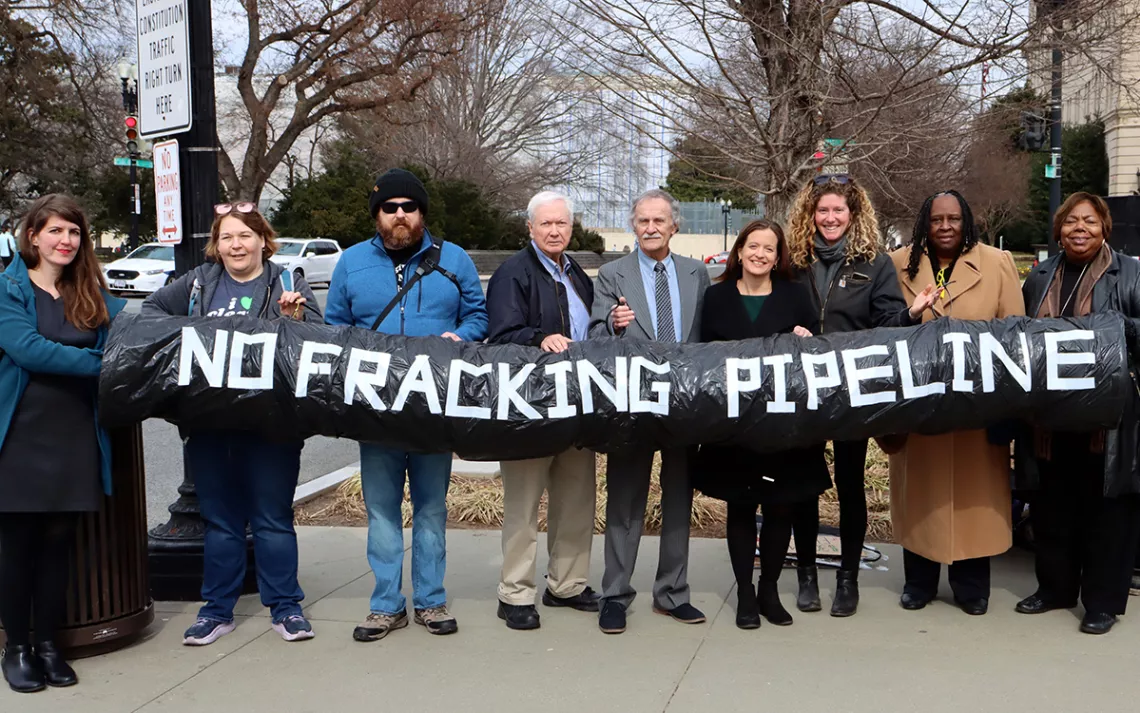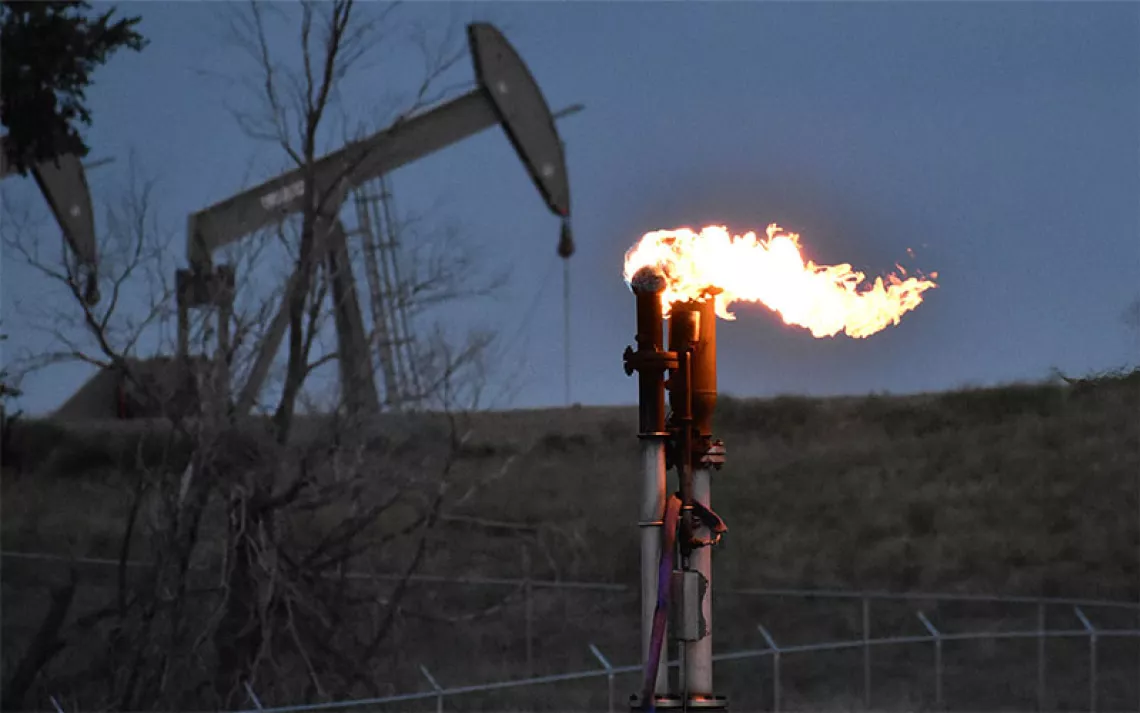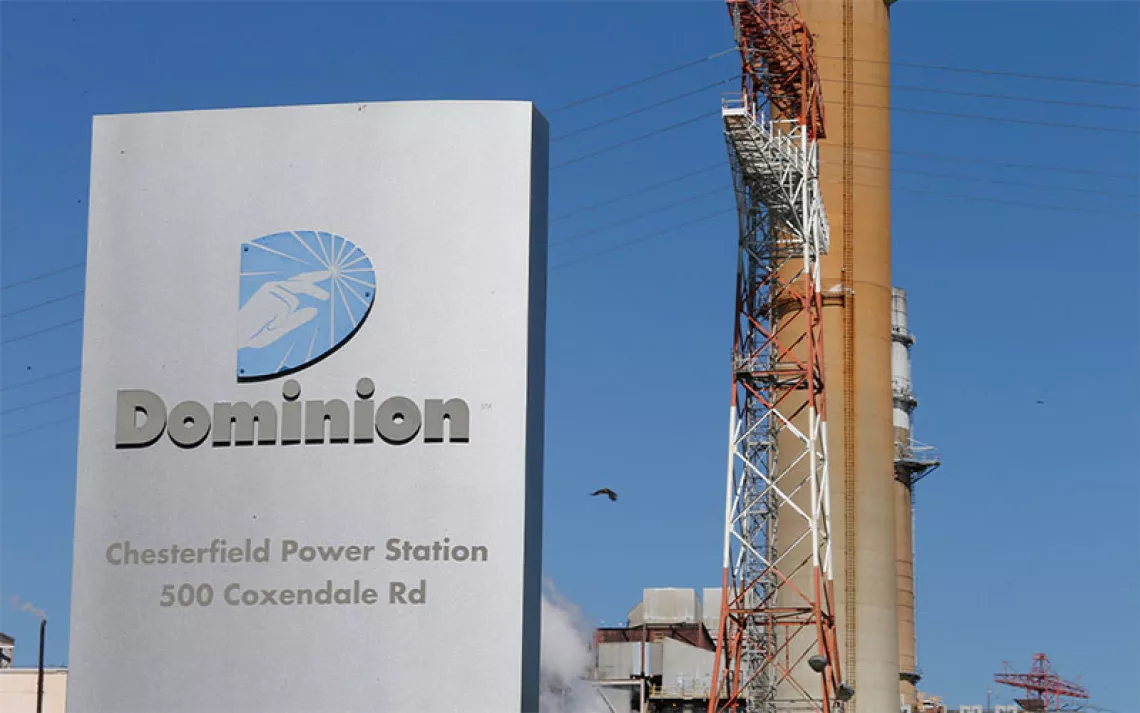Whose Land Is This Land?
A battle over a fracked gas pipeline turns into a fight for the future of energy

Photo courtesy of Javier Sierra
Update: On June 16, 2020, the US Supreme Court ruled that the US Forest Service does have the authority to grant fossil fuel company Dominion Energy Inc. an easement to build its proposed fracked gas pipeline underneath the Appalachian Trial. In a 7-2 decision authored by Justice Clarence Thomas, the court ruled that the land on which the Appalachian Trail sits is owned by the federal government, and hence subject to USFS oversight. In a statement, Kelly Martin, director of the Sierra Club's Beyond Dirty Fuels campaign, said, "This decision is just plugging one hole on a sinking ship." The 600-mile-long Atlantic Coast Pipeline still needs a half dozen permits and approvals unassociated with the Supreme Court decision before it can be completed.
The Appalachian Trail winds for over 2,000 miles from Georgia to Maine, through state, federal, and private land. Some portions of the trail run alongside city streets, like in Hot Springs, North Carolina. Some portions of the trail cross rivers, like the Kennebec River in Maine. And some portions of the trail cross through national forest, like the George Washington and Jefferson National Forests that cover parts of Virginia, West Virginia, and Kentucky.
Typically, land within a national forest is managed by the US Forest Service, while the Appalachian Trail itself is administered by the National Park Service. The Forest Service, for its part, is authorized to allow the development of national forests for multiple uses, meaning that it can grant permits to industries that want to use the resources of the national forest to their benefit. But what about the parts of the Appalachian Trail that cross through a national forest—are those areas Forest Service land, or Park Service land?
That is largely the question that the Supreme Court sought to answer when it heard oral arguments Monday in Atlantic Coast Pipeline LLC v. Cowpasture River Preservation Association. The case concerns the Atlantic Coast Pipeline, a joint venture of the energy giants Dominion Energy and Duke Energy that would carry fracked gas from the Marcellus Shale in West Virginia to Virginia and North Carolina. In 2017, the Forest Service issued the necessary permits for the pipeline to cross a portion of the Appalachian Trail that runs through the George Washington National Forest. Environmental and conservation groups, including the Sierra Club, sued to overturn the permits. Eventually, a federal court of appeals ruled that the permits were invalid because, among other things, the Forest Service lacked jurisdiction under the 1920 Mineral Leasing Act to grant a right-of-way for a pipeline on any land in the national parks system.
In one sense, the Supreme Court’s decision in Atlantic Coast Pipeline will have a limited impact on the pipeline’s future. The court of appeals vacated eight permits based on four independent grounds, including an inadequate environmental review process and an inadequate consideration of alternative routes. The pipeline’s construction has been plagued by delays and beleaguered by community protests. Because of these setbacks, developers have seen the cost of the pipeline balloon to $8 billion from the original price tag of about $5 billion. Even if the Supreme Court rules in favor of the pipeline, it doesn’t necessarily mean that the pipeline will ever become operational.
But don’t mistake the fate of this single pipeline for the fate of fossil fuel development in the United States, particularly across some of the country’s most beloved natural lands. Even if a favorable decision won’t automatically save the Atlantic Coast Pipeline, there’s a reason that the energy companies petitioned the Supreme Court to hear the issue. This case is not just about the one pipeline; it’s about all the pipelines to come.
On a map, the national park system is a scattershot constellation of the 84 million acres that constitute the US national parks. While there are notable exceptions in the West and in Alaska, in most places, a national park is an island unto itself; the parks may be numerous, but they relatively isolated from one another. That isolation creates gaps between the boundaries of the parks that, as the attorney for the pipeline companies told the Supreme Court, are “easy enough to steer a pipeline around.” But take a look at the National Trails System—which was created by Congress in 1968 to allow for “the establishment of a national system of recreation and scenic trails”—and things change. Unlike the park system, the National Trails System runs like rivulets across the entire map. The Appalachian Trail follows the length of the East Coast; in the center of the country, the Lewis and Clark Trail cuts down the middle of the Dakotas into the heart of the Midwest. And in California and Oregon, the California Historic Trail curves through a thicket of national parks and national forests as its tributaries reach for the Pacific.
The environmental groups in Atlantic Coast Pipeline don’t suggest that an oil and gas pipeline can never cross any land in the National Trails System. But just as the Mineral Leasing Act of 1920 prohibits the construction of pipeline on National Park Service land without congressional approval, environmental groups argue that pipelines cannot be built across national trails land that is administered by the Park Service without congressional approval. Put another way, if federal land is administered by the National Park Service, environmentalists argued before the court, it is necessarily national park system land. And Congress has made it very clear that you can’t build oil and gas pipelines on federal land in a national park without congressional approval.
If the Supreme Court were to side with the environmental groups, it would mean that, on the map of the United States, the gaps between the national parks where it is currently “easy enough to steer a pipeline around” would constrict, if only just a little bit. It wouldn’t make pipeline construction impossible, by any stretch. The Appalachian Trail, which is a patchwork of federal, state, and private land, wouldn’t become the “impermeable barrier” that Chief Justice John Roberts described at oral argument. Companies like Duke and Dominion could still construct a pipeline across the Appalachian Trail. They would just have to do it across private, local, or state land.
Limitations, of course, create costs, which is perhaps the real reason that Duke Energy (which earned $2.7 billion in 2018) and Dominion (which earned $2.6 billion over the same period) would balk at the idea of having to choose from a slightly more limited set of options for delivering fossil fuels to consumers. Pipelines are already a costly venture, and fossil fuels are a bad investment. To capitalize on as much profit as possible, energy companies need to build their oil and gas pipelines now.
That, ultimately, is the problem that the energy companies asked the Supreme Court to solve—and the problem that the court’s conservative justices seem most eager to answer. Describing the consequences of the environmental groups’ argument as “enormous,” Justice Brett Kavanaugh, joined by Chief Justice Roberts and Justices Neil Gorsuch and Samuel Alito, appeared deeply skeptical of the idea that Congress would ever intend to make the Appalachian Trail off-limits to oil and gas pipelines (per his usual silence, Justice Clarence Thomas did not ask a question at oral argument).
“You would expect to see clear language like that to generate the significant consequences that your position has,” Kavanaugh told the environmental groups’ attorney. “You have textual arguments, the other side has textual arguments, but your position has significant consequences to it, enormous consequences.” Later, Justice Alito described the environmental groups’ claim as a “gotcha” argument, patched together through a lucky confluence of statutory language.
The court’s conservative justices did not, at oral argument, acknowledge the enormous consequences on the other side of the ledger; that is, the consequences that have already come from the unfettered extraction and consumption of fossil fuels, like the gas that the Atlantic Coast Pipeline would carry to the eastern seaboard. Nor did the conservative justices signal any discomfort with the consequence of upending parts of the Appalachian Trail for a pipeline intended to serve a demand that might not exist.
At one point, Justice Stephen Breyer—considered to be part of the court’s more liberal arm—suggested that the pipeline developers might be able to win on narrower grounds than a sweeping proclamation that national trail lands administered by the Park Service are not units of the national park system.
“I represent the Atlantic Coast Pipeline,” the attorney for the pipeline replied. “It's not my job to resist winning this case on a narrow ground.”
But with a five-to-four conservative majority, the Supreme Court seems poised to give the pipeline company the broad victory it desires, thwarting environmentalists’ attempts to limit, even slightly, the land across which oil and gas pipelines can be built in this country. Our national trails, the court seems ready to rule, are important—just not so important as a company’s right to bring fossil fuels to market. The consequences of hindering an energy company’s profits are “enormous"; the consequences of allowing the unfettered extraction and use of fossil fuels, at least to the court’s conservative majority, merits no consideration.
It is a sobering vision of our country’s energy future. Perhaps more importantly, it is a sobering look into the role that the courts will play in halting—or hastening—the climate crisis.
 The Magazine of The Sierra Club
The Magazine of The Sierra Club



